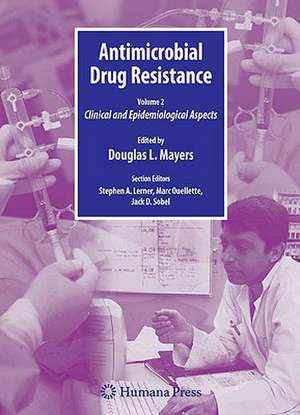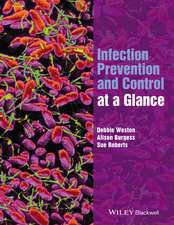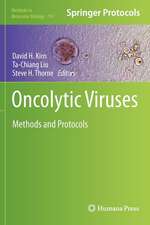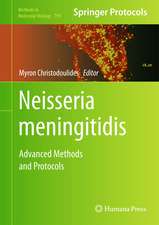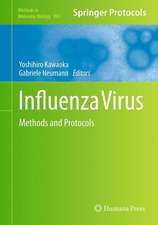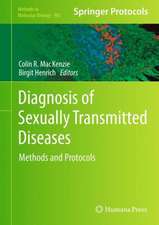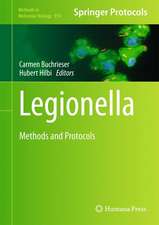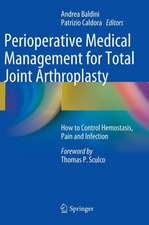Antimicrobial Drug Resistance: Clinical and Epidemiological Aspects, Volume 2: Infectious Disease
Editat de Douglas Mayersen Limba Engleză Hardback – 20 iul 2009
| Toate formatele și edițiile | Preț | Express |
|---|---|---|
| Paperback (2) | 1837.34 lei 38-44 zile | |
| Humana Press Inc. – 23 aug 2016 | 1837.34 lei 38-44 zile | |
| Humana Press Inc. – 30 oct 2014 | 1961.39 lei 6-8 săpt. | |
| Hardback (3) | 1364.22 lei 38-44 zile | |
| Humana Press Inc. – 20 iul 2009 | 1364.22 lei 38-44 zile | |
| Humana Press Inc. – 20 iul 2009 | 1365.85 lei 38-44 zile | |
| Humana Press Inc. – 24 iul 2009 | 1680.21 lei 38-44 zile |
Din seria Infectious Disease
- 5%
 Preț: 1435.28 lei
Preț: 1435.28 lei - 5%
 Preț: 1430.35 lei
Preț: 1430.35 lei - 18%
 Preț: 723.51 lei
Preț: 723.51 lei - 5%
 Preț: 801.13 lei
Preț: 801.13 lei - 5%
 Preț: 683.03 lei
Preț: 683.03 lei - 5%
 Preț: 1110.72 lei
Preț: 1110.72 lei - 5%
 Preț: 1094.25 lei
Preț: 1094.25 lei - 5%
 Preț: 1414.80 lei
Preț: 1414.80 lei - 5%
 Preț: 1101.37 lei
Preț: 1101.37 lei - 5%
 Preț: 790.88 lei
Preț: 790.88 lei - 5%
 Preț: 1027.15 lei
Preț: 1027.15 lei - 18%
 Preț: 1280.72 lei
Preț: 1280.72 lei - 5%
 Preț: 2038.62 lei
Preț: 2038.62 lei - 18%
 Preț: 944.99 lei
Preț: 944.99 lei - 5%
 Preț: 1414.29 lei
Preț: 1414.29 lei - 5%
 Preț: 1113.99 lei
Preț: 1113.99 lei - 5%
 Preț: 1431.81 lei
Preț: 1431.81 lei - 5%
 Preț: 1121.69 lei
Preț: 1121.69 lei - 5%
 Preț: 1117.65 lei
Preț: 1117.65 lei - 5%
 Preț: 1612.30 lei
Preț: 1612.30 lei - 5%
 Preț: 723.05 lei
Preț: 723.05 lei - 18%
 Preț: 1253.42 lei
Preț: 1253.42 lei - 5%
 Preț: 1321.71 lei
Preț: 1321.71 lei - 5%
 Preț: 1427.62 lei
Preț: 1427.62 lei - 5%
 Preț: 725.04 lei
Preț: 725.04 lei - 5%
 Preț: 712.60 lei
Preț: 712.60 lei
Preț: 1364.22 lei
Preț vechi: 1436.02 lei
-5% Nou
Puncte Express: 2046
Preț estimativ în valută:
261.03€ • 272.57$ • 215.56£
261.03€ • 272.57$ • 215.56£
Carte tipărită la comandă
Livrare economică 11-17 aprilie
Preluare comenzi: 021 569.72.76
Specificații
ISBN-13: 9781603275941
ISBN-10: 1603275940
Pagini: 720
Ilustrații: XXVI, 692 p.
Dimensiuni: 210 x 279 x 44 mm
Greutate: 1.79 kg
Ediția:2009
Editura: Humana Press Inc.
Colecția Humana
Seria Infectious Disease
Locul publicării:Totowa, NJ, United States
ISBN-10: 1603275940
Pagini: 720
Ilustrații: XXVI, 692 p.
Dimensiuni: 210 x 279 x 44 mm
Greutate: 1.79 kg
Ediția:2009
Editura: Humana Press Inc.
Colecția Humana
Seria Infectious Disease
Locul publicării:Totowa, NJ, United States
Public țintă
ResearchCuprins
Gram-Positive Bacterial Drug Resistance – Clinical.- Resistance in Streptococcus pneumoniae.- Antibiotic Resistance of Non-Pneumococcal Streptococci and Its Clinical Impact.- Enterococcus: Antimicrobial Resistance in Enterococci Epidemiology, Treatment, and Control.- Antimicrobial Resistance in Staphylococci: Mechanisms of Resistance and Clinical Implications.- Resistance in Aerobic Gram-Positive Bacilli.- Gram-Negative Bacterial Drug Resistance – Clinical.- Antibiotic Resistance in Neisseria.- Mechanisms of Resistance in Haemophilus influenzae and Moraxella catarrhalis.- Enterobacteriaceae.- Pseudomonas aeruginosa.- Acinetobacter.- Antimicrobial Resistance of Shigella spp., Typhoid Salmonella and Nontyphoid Salmonella.- Antimicrobial Resistance in Vibrios.- Antimicrobial Resistance in Helicobacter and Campylobacter.- Pertussis (Whooping Cough).- Antibiotic Resistance of Anaerobic Bacteria.- Mycobacteria: Tuberculosis.- Drug Resistance by Non-Tuberculous Mycobacteria.- Fungal Drug Resistance – Clinical.- The Role of Resistance in Candida Infections: Epidemiology and Treatment.- Antifungal Resistance: Aspergillus.- Drug Resistance in Cryptococcus neoformans.- Antifungal Drug Resistance in Histoplasmosis.- Drug Resistance in Pneumocystis jirovecii.- Viral Drug Resistance – Clinical.- Antiviral Resistance in Influenza Viruses: Clinical and Epidemiological Aspects.- Herpesvirus Resistance.- Clinical Implications of HIV-1 Drug Resistance.- Clinical Implications of Resistance for Patients with Chronic Hepatitis B.- Parasitic Drug Resistance – Clinical.- Antimalarial Drug Resistance: Clinical Perspectives.- Diagnosis and Treatment of Metronidazole-Resistant Trichomonas vaginalis Infection.- Drug Resistance in Leishmania: Clinical Perspectives.- Human AfricanTrypanosomiasis.- Drug Resistance in Toxoplasma gondii.- Drug Resistance in the Sheep Nematode Parasite Haemonchus contortus, Mechanisms and Clinical Perspectives.- Measurements of Drug Resistance.- In Vitro Performance and Analysis of Combination Anti-infective Evaluations.- Antimicrobial Susceptibility Testing Methods for Bacterial Pathogens.- Drug Resistance Assays for Mycobacterium tuberculosis.- Fungal Drug Resistance Assays.- Viral Phenotypic Resistance Assays.- Drug Resistance Assays for Parasites.- Genotypic Drug Resistance Assays.- The Use of Genotypic Assays for Monitoring the Development of Resistance to Antiviral Therapy for HIV-1 Infection and Other Chronic Viral Diseases.- Public Health Issues of Drug Resistance.- Antimicrobial Resistance: An International Public Health Problem.- Hospital Infection Control: Considerations for the Management and Control of Drug-Resistant Organisms.- Controlling the Spread of Resistant Pathogens in the Intensive Care Unit.- Implications of Antibiotic Resistance in Potential Agents of Bioterrorism.- Internet Resources on Antimicrobial Resistance.
Recenzii
From the reviews:
“This book is a comprehensive guide to the state of the field as far as clinical practice is concerned. … There is good coverage of the wider spectrum of pathogens: viruses, fungi and parasites are addressed as well as bacterial infections. Each contribution is exhaustive and will appeal very much to the clinical microbiologist and infectious disease specialist. … This is certainly a reference book, and every diagnostic laboratory would derive value in having a copy on its shelves.” (Colin Howard, Microbiology Today, June, 2010)
“This book is a comprehensive guide to the state of the field as far as clinical practice is concerned. … There is good coverage of the wider spectrum of pathogens: viruses, fungi and parasites are addressed as well as bacterial infections. Each contribution is exhaustive and will appeal very much to the clinical microbiologist and infectious disease specialist. … This is certainly a reference book, and every diagnostic laboratory would derive value in having a copy on its shelves.” (Colin Howard, Microbiology Today, June, 2010)
Textul de pe ultima copertă
The volumes included in Antimicrobial Drug Resistance represent the first comprehensive, multidisciplinary reference covering the area of antimicrobial drug resistance in bacteria, fungi, viruses, and parasites from basic science, clinical, and epidemiological perspectives.
The first volume, Antimicrobial Drug Resistance, Mechanisms of Drug Resistance, is dedicated to the biological basis of drug resistance and effective avenues for drug development. With the emergence of more drug-resistant strains, the approach to dealing with the drug resistance problem must include the research of different aspects of the mechanisms of bacterial resistance and the dissemination of resistance genes as well as research utilizing new genomic information. These approaches will permit the design of novel strategies to develop new antibiotics and preserve the effectiveness of currently available ones.
The second volume, Antimicrobial Drug Resistance, Clinical and Epidemiological Aspects, is devoted to the clinical aspects of drug resistance. Although there is evidence that restricted use of a specific antibiotic can be followed by a decrease in drug resistance to that agent, drug resistance control is not easily achieved. Thus, the infectious disease physician requires input from the clinical microbiologist and infection control specialist to make informed choices for the effective treatment of various strains of drug-resistant pathogens in individual patients.
This 2-volume set is an important reference for students in microbiology, infectious disease physicians, medical students, basic scientists, drug development researchers, microbiologists, epidemiologists, and public health practitioners.
The first volume, Antimicrobial Drug Resistance, Mechanisms of Drug Resistance, is dedicated to the biological basis of drug resistance and effective avenues for drug development. With the emergence of more drug-resistant strains, the approach to dealing with the drug resistance problem must include the research of different aspects of the mechanisms of bacterial resistance and the dissemination of resistance genes as well as research utilizing new genomic information. These approaches will permit the design of novel strategies to develop new antibiotics and preserve the effectiveness of currently available ones.
The second volume, Antimicrobial Drug Resistance, Clinical and Epidemiological Aspects, is devoted to the clinical aspects of drug resistance. Although there is evidence that restricted use of a specific antibiotic can be followed by a decrease in drug resistance to that agent, drug resistance control is not easily achieved. Thus, the infectious disease physician requires input from the clinical microbiologist and infection control specialist to make informed choices for the effective treatment of various strains of drug-resistant pathogens in individual patients.
This 2-volume set is an important reference for students in microbiology, infectious disease physicians, medical students, basic scientists, drug development researchers, microbiologists, epidemiologists, and public health practitioners.
